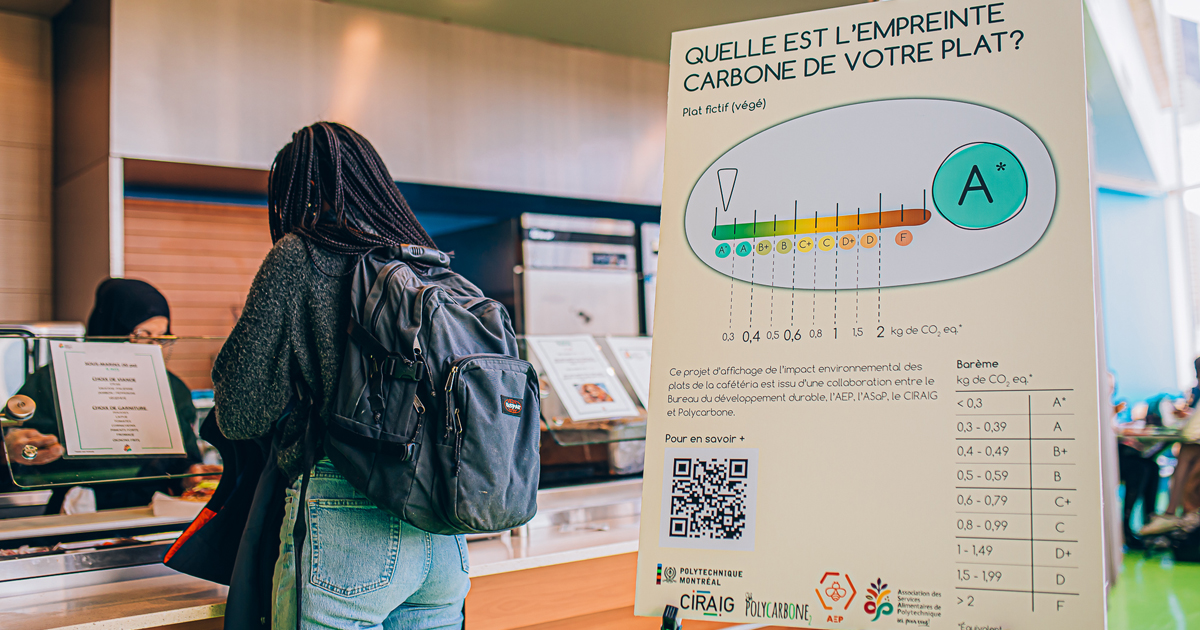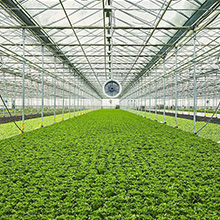Nouvelles
A Canadian first: Polytechnique Montréal displays the carbon footprint of its cafeteria meals
Polytechnique Montréal, always at the leading edge of future-oriented solutions, is innovating by quantifying the greenhouse gas (GHG) emissions generated by its cafeteria meals. Only a handful of institutions worldwide—restaurants and others—have experimented with this approach, and Polytechnique is the first in Canada to do so.

(Photo: Caroline Perron)
In an innovative “environmental labelling” initiative, the engineering university is launching a new plan to tag the hot meals served in its main cafeteria with a grade that reflects their carbon footprint. The aim of this new labelling system is to increase awareness among the members of the Poly community as to the environmental impact of the contents of the food they are eating.
“The great thing about the new generation of engineers is that they have a desire for lasting change; their commitment is not restricted to the professional domain,” says Patrick Cigana, Senior Advisor, Office of Sustainability. He adds: “Polytechnique Montréal is proud to provide a learning environment that stimulates the acquisition of a wide range of knowledge about a responsible future.”
A measured challenge
Engineering is all about optimization and improvement. On average, in Quebec, our food consumption generates one-quarter of our individual carbon footprint. This issue became even more evident in light of the results of the university’s institutional life-cycle assessment (LCA), which were published in February 2020. The exercise ranked meat as a hot-button issue at Polytechnique, attributing 80% of the GHG emissions from the university’s food services to meals containing meat (beef or pork).
Polytechnique had already pioneered by producing this thorough carbon assessment and is now moving further along by taking significant action on climate proactivity. “The data have identified food as one of the areas of opportunity for progress,” notes Louise Millette, head of the Office of Sustainability, adding: “There is a need for information to raise awareness and encourage habits that consume less energy.”

Left to right: Antoine Doray (AEP), Valérie Ayotte-Bouchard (PolyCarbone), Patrick Cigana (Bureau du développement durable), Lysanne Blais-Gingras (CIRAIG), Catherine Houssard (CIRAIG), Kévin Gréard (ASaP). (Photo: Caroline Perron)
Lifecycle approach
The project would not have been possible without the participation of the team from the Polytechnique-affiliated Centre international de référence sur l’analyse du cycle de vie et la transition durable (international reference centre for lifecycle assessment and sustainable transition, better known by its French acronym CIRAIG), with whom cafeteria managers shared their recipes. The CIRAIG’s expertise in carbon-footprint quantification formed the heart of the project. The CIRAIG tracked the GHG emissions of the cafeteria menu items at each stage of their lifecycle: production, processing, distribution, preparation, and cooking, as well as packaging waste management.
Communication with the community
To help its community understand the data obtained, Polytechnique developed an easily “digestible” communications approach. The first step was to determine the carbon footprint of the meals. An impact score was calculated from the quantities of GHGs inventoried and their global warming potential. This score—expressed in CO2-equivalent kilograms (or kg CO2-eq)—was transposed to a grading scale, the same one used for Polytechnique courses. With this system, the hot meals ordered by cafeteria customers are graded from A* to F.
A table like the one below will be made available every Thursday for the hot meals in the cafeteria:

Which to choose?
Interestingly, meals graded between A* and D+ have a smaller carbon footprint than the average omnivorous meal in Quebec.
“Such dishes should be chosen in order to reduce the impact of our diet on global warming,” says Catherine Houssard, who piloted CIRAIG’s contribution to the project. “The good news is that all the recipes analysed obtained a passing grade of D+ or better.”
As the weeks go by, cafeteria users will discover grades that are sometimes surprising, but always enlightening. Some white-meat dishes, for example, perform better than some vegetarian options. Similarly, vegetarian dishes that contain cheese (focaccia, quiche) generate much more GHGs than those that do not.
Detailed explanations and results for each dish (methodology, scope of the study and data used) can be found online (in French only): https://www.asap-polymtl.ca/projet-etiquetage.
Going forward
The project is currently in a trial phase and the “green labelling” is available every Thursday for the hot meals in the main cafeteria. The plan is to extend the exercise to all items prepared daily in the university’s kitchens.




